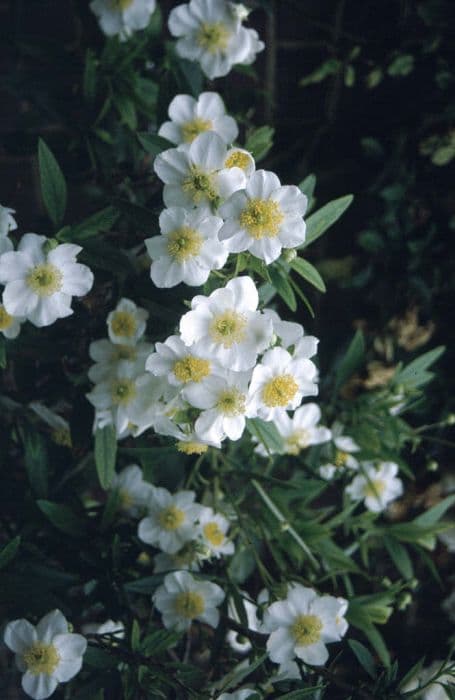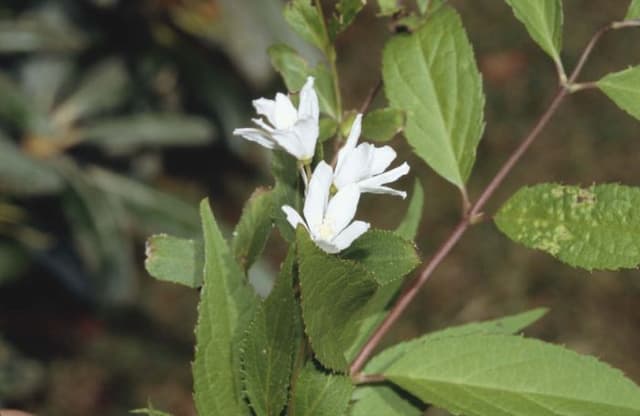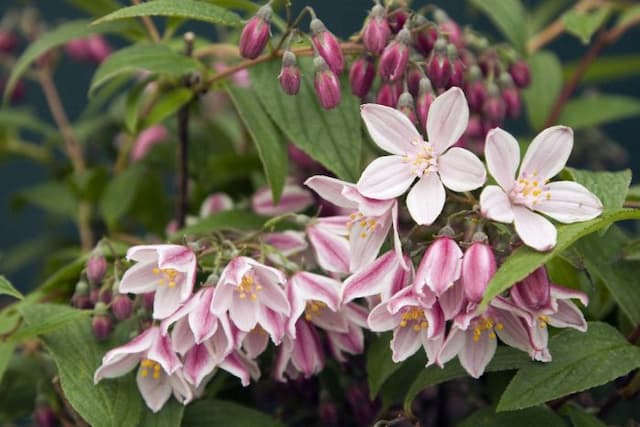Variegated Mock Orange Philadelphus coronarius 'Variegatus' (v)

ABOUT
Philadelphus coronarius 'Variegatus', commonly known as the variegated mock orange, is a notably attractive deciduous shrub cherished for its decorative foliage and fragrant blooms. Its leaves are a defining feature, with a vivid green center and irregular creamy white margins, creating a striking variegation that adds visual interest even when the plant is not in flower. The leaves are ovate in shape and possess a slightly serrated edge, contributing to the plant's textured appearance. Come late spring to early summer, the variegated mock orange is adorned with clusters of showy flowers. These blossoms are commonly four-petaled, radiating from the center like a cross. Their hue is a pure, bright white which stands out eloquently against the variegated leaves. Coupled with their beauty is a powerful and sweet fragrance, reminiscent of orange blossoms, which envelops the surrounding area and makes the plant even more appealing. Though its specific dimensions are to be excluded, it is widely appreciated for its bushy, fountain-like growth habit, which gives it a lush and full appearance. The stems are often arching, contributing to the plant's overall graceful structure. The variegated mock orange is appreciated for its ornamental qualities in gardens, where it provides a lovely contrast with other plants, and its sensory attributes, particularly the enchanting aroma of its flowers, are a delight in any outdoor space.
About this plant
 Names
NamesFamily
Hydrangeaceae.
Synonyms
Variegated Mock Orange, Variegated Sweet Mock Orange, Variegated English Dogwood.
Common names
Philadelphus coronarius 'Variegatus'.
 Toxicity
ToxicityTo humans
The Mock Orange (Philadelphus coronarius 'Variegatus') is generally considered non-toxic to humans, and there are no widely recognized symptoms of poisoning from this plant. However, as with any plant material, it is possible that some people might experience mild stomach upset or an allergic reaction if ingested or handled. It is always prudent to avoid eating parts of ornamental plants that are not known to be edible.
To pets
Mock Orange (Philadelphus coronarius 'Variegatus') is also not known to be toxic to pets. There is no significant evidence to suggest that this plant causes poisoning in pets such as dogs and cats. Nonetheless, pets should not be encouraged to eat ornamental plants, as they could potentially cause gastrointestinal upset or an allergic reaction.
 Characteristics
CharacteristicsLife cycle
Perennials
Foliage type
Deciduous
Color of leaves
Variegated
Flower color
White
Height
5-6 feet (1.5-1.8 meters)
Spread
5-6 feet (1.5-1.8 meters)
Plant type
Shrub
Hardiness zones
5-8
Native area
Southeast Europe
Benefits
 General Benefits
General Benefits- Aesthetic Appeal: The Philadelphus coronarius 'Variegatus', commonly known as mock orange, has beautifully variegated leaves that add visual interest to the garden.
- Fragrant Blooms: Mock orange is renowned for its delightfully fragrant white flowers that bloom in late spring to early summer, creating a pleasant olfactory experience.
- Attracts Pollinators: The flowers provide nectar for bees and other pollinators, helping to support local ecosystems.
- Easy Maintenance: This shrub is known for being low-maintenance, requiring minimal care once established, making it suitable for beginner gardeners.
- Drought Tolerance: Once established, mock orange has good drought tolerance, making it suitable for gardens with less frequent water availability.
- Tolerance of Different Soil Types: It adapts to a wide range of soil types, although it prefers well-drained soils, giving it versatility in landscape use.
- Screening and Privacy: With its dense growth habit, it can be used as a hedge or screen, providing privacy and reducing noise from surroundings.
- Wildlife Habitat: The dense foliage offers shelter and nesting sites for birds and other wildlife.
- Seasonal Interest: In addition to its spring blooms, mock orange also provides seasonal interest with its foliage changing color in the fall.
- Versatile Landscaping: Suitable for mixed borders, foundation plantings, and as a specimen plant, mock orange can fit into various garden designs and styles.
 Medical Properties
Medical PropertiesThis plant is not used for medical purposes.
 Air-purifying Qualities
Air-purifying QualitiesThis plant is not specifically known for air purifying qualities.
 Other Uses
Other Uses- Philadelphus coronarius 'Variegatus', commonly known as Variegated Mock Orange, can be utilized in cut flower arrangements, adding a refreshing citrus scent and a touch of delicate white flowers to bouquets.
- The shrub's dense growth habit makes it suitable for creating informal privacy hedges or screens in gardens and landscapes.
- Variegated Mock Orange's distinctive foliage, with green leaves edged in creamy white, can be used to add contrast and visual interest in mixed shrub borders.
- The plant serves as shelter and nesting sites for birds, offering protection and a safe place to raise their young in a garden setting.
- Due to its vigorous root system, it is sometimes used for erosion control on slopes and along banks to stabilize soil and prevent runoff.
- The branching structure of Variegated Mock Orange offers winter interest, with the plant's silhouette adding textural beauty to a dormant garden.
- The fragrant flowers of the shrub can be used in potpourri mixes, adding a natural and sweet scent to homemade blends.
- The shrub can be incorporated into sensory gardens, exploiting its strong citrus fragrance and textured foliage to stimulate the senses.
- Variegated Mock Orange can be planted in large containers or pots for patio gardens or outdoor living areas where space is limited.
- When pruned and shaped, the plant can be utilized for topiary, creating living sculptures that serve as focal points in formal gardens.
Interesting Facts
 Feng Shui
Feng ShuiThe Mock Orange is not used in Feng Shui practice.
 Zodiac Sign Compitability
Zodiac Sign CompitabilityThe Mock Orange is not used in astrology practice.
 Plant Symbolism
Plant Symbolism- Innocence: Philadelphus coronarius, commonly known as Mock Orange, often symbolizes innocence due to its pure white flowers.
- Purity: The pristine nature of its blossoms associates Mock Orange with purity and the idea of unspoiled beauty.
- Peace: The soothing scent of Mock Orange blossoms is thought to bring peace and calm, making it emblematic of tranquility.
- Renewal: As a deciduous shrub that blooms in late spring, Mock Orange is indicative of renewal and the fresh start that comes with the season.
- Eternal Love: Historically, the everlasting nature of Mock Orange's fragrance was believed to symbolize eternal love.
 Water
WaterThe Mock Orange should be watered deeply to ensure the roots receive adequate moisture, which typically means applying about 1 to 1.5 inches of water once a week. During the first growing season, it's crucial to maintain a consistent watering schedule to establish a strong root system. When the plant is established, it's resilient to short periods of drought. However, during prolonged dry spells or in extremely hot conditions, additional watering every few days may be necessary. Always check the soil moisture before applying water; the soil should be moist but not waterlogged.
 Light
LightMock Orange thrives best in full sun to partial shade. Ideally, it should be placed where it can receive at least four to six hours of direct sunlight per day. While it's adaptable to light conditions, more sun exposure encourages better flowering. However, in regions with extremely hot summers, some afternoon shade will help protect the plant from excessive heat.
 Temperature
TemperatureThe Mock Orange prefers temperate conditions and can typically survive winter temperatures as low as 20 degrees Fahrenheit and summer temperatures around 90 degrees Fahrenheit. The ideal growing temperatures for Mock Orange range from 60 to 75 degrees Fahrenheit. Protecting the plant from harsh winter winds is beneficial, but it generally tolerates a wide range of temperature fluctuations within its hardiness zones.
 Pruning
PruningPrune Mock Orange immediately after flowering, typically in late spring or early summer, to maintain its shape and encourage vigorous growth. Remove any dead or damaged wood and thin out old branches to allow light into the center of the shrub. Pruning at this time ensures that you won't be cutting off next year's buds, as Mock Orange blooms on the previous year's growth.
 Cleaning
CleaningAs needed
 Soil
SoilMock Orange ('Variegatus') prefers well-draining, fertile soil with a pH range of 6.0 to 8.0. An ideal soil mix would consist of garden soil, compost, and sand or perlite to enhance drainage. Regularly adding organic matter helps maintain soil fertility for optimal growth.
 Repotting
RepottingMock Orange ('Variegatus') is typically grown in-ground and does not require repotting. If grown in a container, repot every few years in the spring to refresh the soil and accommodate root growth.
 Humidity & Misting
Humidity & MistingMock Orange ('Variegatus') is adaptable to a wide range of humidity levels and does not require high humidity; average outdoor conditions are generally suitable.
 Suitable locations
Suitable locationsIndoor
Provide bright light, keep soil moist, and ensure good air circulation.
Outdoor
Plant in full sun to partial shade; mulch and water regularly.
Hardiness zone
5-9 USDA
 Life cycle
Life cyclePhiladelphus coronarius 'Variegatus', commonly known as the Variegated Mock Orange, begins its life cycle when seeds germinate in spring, typically after a period of cold stratification which breaks dormancy. Seedlings establish in the first year, growing into juvenile plants with characteristic variegated leaves that are green with white margins. Over the next few years, the shrub grows vigorously, reaching maturity and flowering size, which can be within 2-4 years; blossoms are fragrant, white, and appear in late spring to early summer. Once mature, the Variegated Mock Orange enters a repetitive cycle of flowering annually, typically followed by the development of small, inconspicuous fruit that are generally not showy. With proper care, including annual pruning after flowering to encourage bushy growth and rejuvenation, the shrub can live and continue to bloom for many years. As it ages, if not properly maintained, the plant may become woody and less prolific in flowering, at which point it may require more extensive pruning or rejuvenation practices to restore vitality.
 Propogation
PropogationPropogation time
Spring to early summer
Propogation: The most popular method of propagation for the Mock Orange (Philadelphus coronarius 'Variegatus') is through softwood cuttings. This is typically done in late spring or early summer when the plant's new growth is still tender and flexible. Gardeners should select a healthy stem with new growth and cut a 4 to 6 inch (approximately 10 to 15 cm) length, making the cut just below a node. Removing the lower leaves and dipping the cut end into a rooting hormone can enhance rooting success. The cutting should then be placed in a well-draining soil mix, ensuring at least one node is below the soil surface for root development. The soil should be kept evenly moist, and the cutting should be placed in indirect light until roots have established, which may take several weeks. Once rooted, the new Mock Orange plant can be gradually acclimated to outdoor conditions and then planted in a suitable location in the garden.







![Hydrangea [Strong Annabelle]](/_next/image?url=https%3A%2F%2Fplants-admin.emdemapps.com%2Fimages%2Fplants%2F%2Fimages%2F604b54db37d34.png&w=640&q=75)

